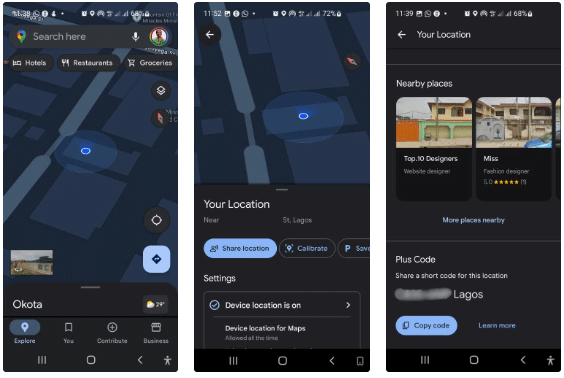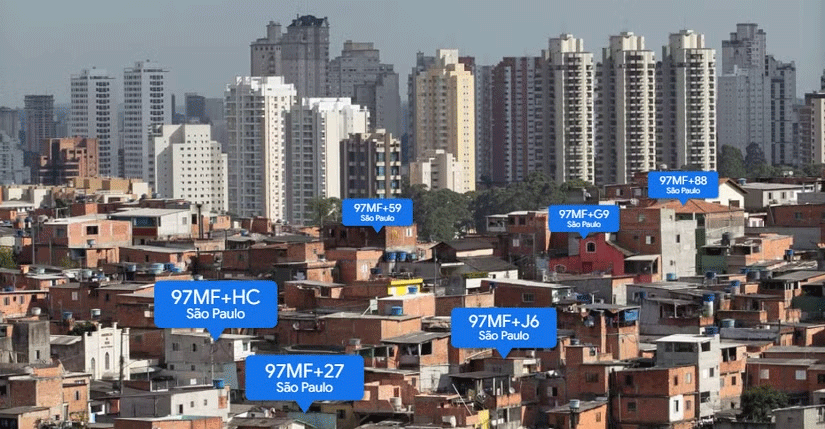How to Share Your Exact Location with Google Plus Codes
That's where Google Plus Codes — a better way for anyone to pinpoint their exact location without any extra effort — comes into play.
How to Share Your Exact Location Using Google Plus Codes
There are two ways to share your exact location using Plus Codes: Using your smartphone or PC.
If you are using a mobile phone, all you need is the Google Maps app.
- Launch the app and you should see a blue dot indicating your current location. If for some reason you don't see this blue dot, tap the Compass icon to get your location back.
- Click the blue dot when you see it.
- Pull up the Your Location banner .
- Scroll to the bottom and you will see your Plus Code with a Copy code button .

The steps are even simpler if you're on a PC. Just visit Plus Codes Map on any browser and allow the site to access your location.

Once you grant permission, you'll see your Plus Code displayed at the bottom of the screen. Just like the mobile app, you can use the Compass icon to retrieve your location if needed.

Just like on mobile, you can easily copy your Plus Code on your PC and use it in delivery apps or put it on your business card.
Plus Code is GPS coordinates that humans can actually understand
Plus Codes is a Google Maps feature that generates a simple code for any location, no matter how remote or hard to describe. They essentially act as digital addresses, converting complex GPS coordinates into a more user-friendly, shareable format.
For example, instead of decimal coordinates (DD) 52.891312 and -97.733937, you would have 9644V7R8+GC.
Each Plus Code is a combination of letters and numbers that represents a specific geographic area. For example, the code 9644V7R8+GC identifies a specific location in Lake Winnipeg, Canada. Even though that area of Lake Winnipeg does not have an official address, it still has a Plus Code because it is based solely on GPS coordinates, not street names or landmarks. This system works anywhere in the world.

In cities like Tokyo, where addresses are often block-based and confusing, or areas where streets don't have names, Plus Codes provide a reliable way to navigate. They're especially useful in developing regions, like parts of Latin America or Africa, where traditional addressing systems may be inconsistent or non-existent.
Imagine a country where locals give directions using landmarks, such as 'turn right after the second oak tree.' Instead of relying on these vague instructions, you could simply ask them for a Plus Code and let Google Maps (or any other app that integrates the Plus Code algorithm) guide you directly.
Because Plus Codes are built into Google Maps, they're easy to use in everyday situations—whether you're sharing directions to a coffee shop or finding a remote trail. While not all delivery services support Plus Codes, they're still useful for navigating large parks, festival grounds, or urban areas with hard-to-find addresses.
You should read it
- Google will start deleting photos, comments, pages and more on Google+ from April
- Instructions for creating QR codes in Google Slides
- 11 products of Google are little known
- Chrome will also display an error code, similar to Windows 'blue screen of death'
- 18 interesting 'bombs' of Google
- Some common error codes on CH Play and how to fix them
- 14 great features on Google you may not know yet
- Interesting search engines on Google that you may not know yet
May be interested
- How to share location directly on Messenger
 messenger now allows direct location sharing in real time. accordingly, we can share our current location with our friends in the conversation and they can open the google maps application to find that location.
messenger now allows direct location sharing in real time. accordingly, we can share our current location with our friends in the conversation and they can open the google maps application to find that location. - How to share your iPhone location on iOS 8
 in case you want to share your location with your friends, don't know where it is. you can ask your device to speak with the following simple steps.
in case you want to share your location with your friends, don't know where it is. you can ask your device to speak with the following simple steps. - Google's location data inadvertently turns innocent people into suspects
 one fine day, you take your bike to the street, plan a few laps to relax your mind, don't forget to turn on the location tracking feature on your phone to see how far you are, and then suddenly you're in trouble. with the law. this is exactly what this unlucky man encountered.
one fine day, you take your bike to the street, plan a few laps to relax your mind, don't forget to turn on the location tracking feature on your phone to see how far you are, and then suddenly you're in trouble. with the law. this is exactly what this unlucky man encountered. - Instructions to prevent Google from tracking your location
 to prevent google from tracking your location, many people think that just turning off location history is fine, but this is not enough. so this article will show you how to completely turn off the tracking feature.
to prevent google from tracking your location, many people think that just turning off location history is fine, but this is not enough. so this article will show you how to completely turn off the tracking feature. - How to view and delete your location history on Facebook
 if you enable the location history feature on the facebook application, it will periodically enter your exact location in the location history, even if you are not using the application. fortunately, you can delete the entire location history or delete specific cases and turn off this feature completely.
if you enable the location history feature on the facebook application, it will periodically enter your exact location in the location history, even if you are not using the application. fortunately, you can delete the entire location history or delete specific cases and turn off this feature completely. - Google launched navigation software for mobile phones
 google has just released software that allows mobile users and other wireless devices to automatically share their location with relatives and friends.
google has just released software that allows mobile users and other wireless devices to automatically share their location with relatives and friends. - How to check which websites can access your location in Google Chrome
 in google chrome, websites that you have allowed (granted) to access location data will be able to silently track your location on future visits, without any permission. .
in google chrome, websites that you have allowed (granted) to access location data will be able to silently track your location on future visits, without any permission. . - How to create QR codes with Google Sheets is very simple
 but how can you quickly and easily create and store qr codes even on a large scale? google sheets online spreadsheet tool will help you easily solve this problem.
but how can you quickly and easily create and store qr codes even on a large scale? google sheets online spreadsheet tool will help you easily solve this problem. - Google collects Android location data even when location services are turned off
 are you using an android phone? if the answer is yes, you are one of the billions of users who are being crawled and sent to google secretly.
are you using an android phone? if the answer is yes, you are one of the billions of users who are being crawled and sent to google secretly. - Google keeps track of your location even when Location History is turned off
 to be completely 'invisible', you have to turn off something else.
to be completely 'invisible', you have to turn off something else.









 Why does Windows operating system have such a bad reputation?
Why does Windows operating system have such a bad reputation? What information can your ISP see when you turn on a VPN?
What information can your ISP see when you turn on a VPN? Microsoft's official Windows 11 virtual machine is no longer available
Microsoft's official Windows 11 virtual machine is no longer available Modern malware has more sophisticated ways of hiding
Modern malware has more sophisticated ways of hiding 4 Mistakes to Avoid When Setting Up a Password Manager
4 Mistakes to Avoid When Setting Up a Password Manager Why do so many people downgrade from Windows 11 to Windows 10?
Why do so many people downgrade from Windows 11 to Windows 10?